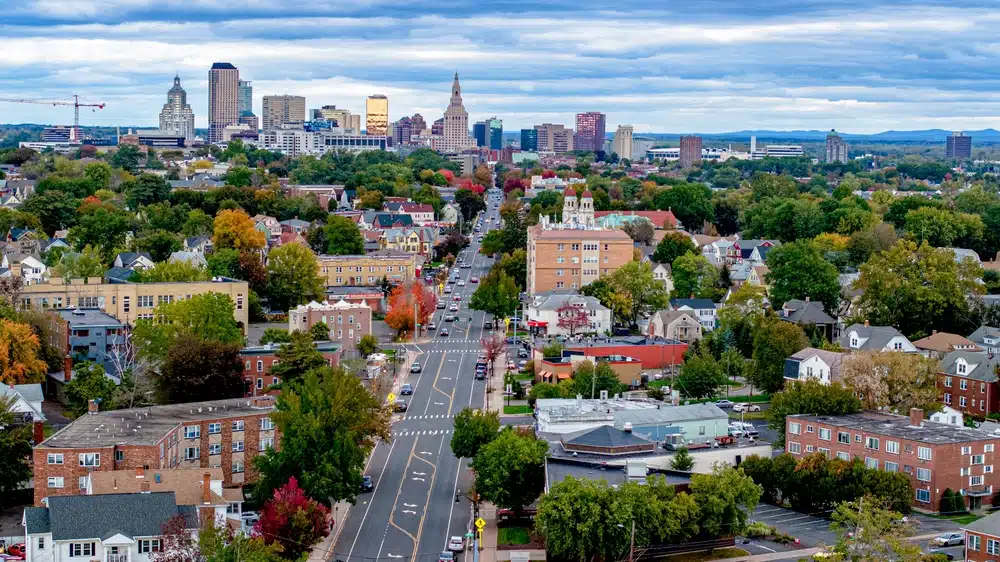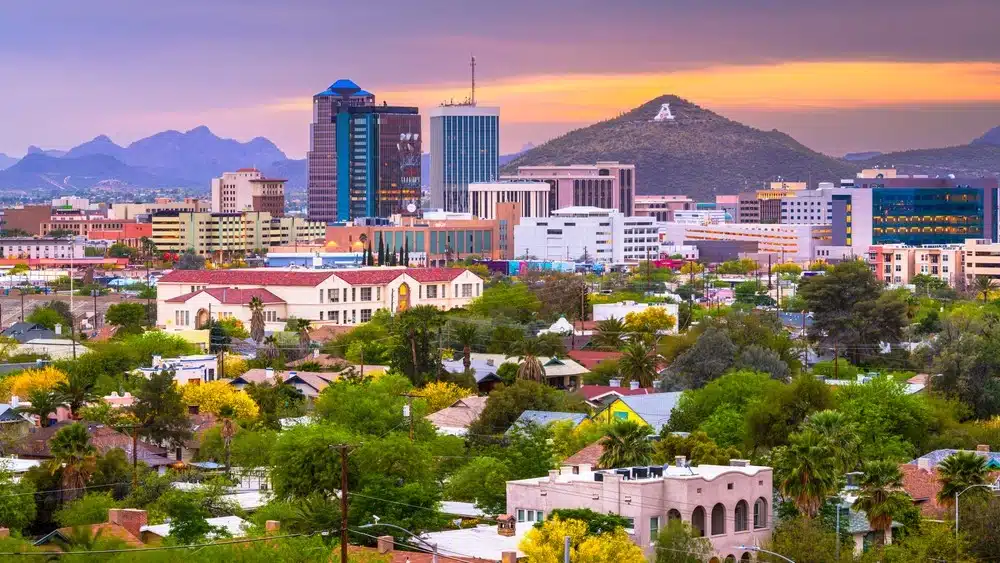Excessive inflation, cussed underemployment in coastal blue states, and slowing progress in purple states are elevating the specter of stagflation within the U.S.
Stagflation, a time period for a cussed financial situation characterised by excessive inflation, excessive unemployment, and sluggish financial progress, was final seen within the U.S. within the Seventies. Whereas present situations aren’t almost as grim, the mixture of higher-than-normal inflation and sluggish hiring is elevating considerations that we might be headed in direction of one thing comparable.
Stagflationary recessions, just like the one the U.S. skilled between 1973 and 1975, can result in extended financial stagnation and are tough to deal with with financial coverage. A lot of these recessions are characterised by each larger costs, together with on shelter, and excessive unemployment.
In its inaugural report, The U.S. States Most Weak To Stagflation in 2025, NationalBusinessCapital.com checked out state and regional knowledge to find out which states is perhaps closest to getting into a stagflationary swamp. Researchers discovered the strongest stagflationary tremors alongside the West Coast, however there are regarding indicators in different areas as properly.
A lot of the ache alongside the Pacific and within the Northeast might be attributed to excessive shelter prices, massive utility payments, and excessive (U6) underemployment. These points had been most pronounced in California (1st), which tops the checklist by a snug lead, however they’re additionally obvious in states like Connecticut (2nd), Oregon (sixth, tied), New York (sixth, tied), and New Jersey (ninth). Pink states like Kentucky (third), nonetheless, face their very own stagflationary dangers within the type of slowing GDP progress, insufficient salaries, and/or low productiveness progress.
Regardless of exhibiting some indicators of a slowing economic system earlier this 12 months, Montana (fiftieth) emerged because the state least susceptible to getting into stagflation because of comparatively low inflation and underemployment, together with fellow landlocked states West Virginia (forty ninth), Utah (forty eighth), Arkansas (forty seventh), Minnesota (forty fifth), and Vermont (forty second, tied). These searching for security inside view of the seaside might need to contemplate North Carolina (forty sixth), South Carolina (forty fourth), or Alabama (forty second, tied).
Key Findings
- Blue States Are Exhibiting Extra Stagflationary Indicators Total: Blue states had a median total stagflationary rating of 53.4, 6.5% larger than purple states, which had an total rating of fifty.1. Blue states, led by California, accounted for 60% of all states within the 10 most at-risk rating. That is, largely, as a result of blue states having extra inflation total, notably relating to shelter and power prices. Blue states are additionally struggling extra with underemployment, with a median U6 unemployment fee of seven.5% to purple states’ 6.8%.
- However Family Budgets And Current Financial Development Are Beneath Extra Stress In Pink States: Whereas blue states usually had larger inflation, the residents of purple states might have much less capability to soak up value will increase, typically attributable to decrease incomes. Round 38% of purple state households reported problem paying payments in comparison with round 34% of blue state households. Bank card delinquency can also be extra frequent in purple states. Pink states additionally noticed extra extreme actual GDP losses (-1.14% to blue states’ -0.83%) throughout 2025’s sluggish Q1, in addition to decrease labor productiveness progress in 2024 (2% vs. 2.8%).
- Pacific States Are Exhibiting The Most Stagflationary Indicators: Regionally, Pacific States had the best common stagflationary rating by a substantial margin at 60.6, adopted by the Northeast (53.1), Midwest (50.5), South (49.2), and Mountain (48.45) areas.
- Over 25% Of Households In Each State Say They Are Struggling To Pay Payments: A median of 36.3% households within the U.S., greater than 1-in-3, are reporting problem paying month-to-month payments. Minnesota had the least confused households at 27.4% whereas Kentucky had essentially the most at 45.6%.
THE 10 STATES MOST AT RISK OF STAGFLATION IN 2025
1. California

Rating (out of 100): 69.0 (1st)
Regardless of having a GDP almost 50% bigger than Texas, the second-largest economic system within the U.S., California has walked with a limp for the reason that pandemic. With the best U6 unemployment fee within the nation (10%), Californians are struggling to seek out work (3.8% job opening fee, third lowest) that retains up with among the stickiest inflation within the nation (135.7 implicit deflator, 1st; 2.7% regional CPI, tenth) and a few of its least inexpensive actual property. Whereas the populations of another states are deeper within the purple, bank card delinquencies (12%, twelfth) are comparatively excessive, as are households reporting problem paying payments (37.9%, sixteenth).
One glimmer of hope for the Golden State relating to avoiding a stagflationary rut: California’s productiveness positive aspects in 2024 had been among the many highest within the nation, 3.9% (forty fifth in productiveness loss).
2. Connecticut

Rating: 64.3 (2nd)
Issues have been getting fairly costly within the Structure State. Private expenditures are manner up (5.2%, 4th) as is inflation (2.8% regional CPI, 1st; 124.9 implicit deflator, tenth). Not like California, Connecticut’s stagflationary dangers aren’t as instant, however the state might have much less wiggle room to dig its manner out ought to it arrive. Private earnings progress has taken out among the sting (4.7%, forty sixth), however bother might be on the horizon because the state’s productiveness (1.7% progress, seventeenth worst) positive aspects lag behind a lot of the nation.
Up to now, Connecticut’s underemployment is on the excessive facet (7.4% U6, twentieth) with out being particularly notable, however that would change given comparatively low job opening charges (4.4%, thirteenth lowest).
3. Kentucky

Rating: 64.1 (third)
Not like the highest two states, Kentucky has suffered comparitively delicate charges of inflation (109 implicit deflator, thirty seventh; 2.4% regional CPI, twentieth). Sadly, Kentuckians have a really restricted capability to soak up value will increase, with 45.6% % of households reporting problem paying their payments (1st). Private earnings progress is among the many lowest within the nation (0.3%, seventh), and underemployment is comparatively frequent (8.3%, ninth). With productiveness positive aspects decrease than most different states (1.5%, 14th lowest) and tepid job progress (4.6% job opening fee, twentieth lowest), Kentucky’s modest inflation dangers turning into stagflationary.
4. Alaska

Rating: 63.5 (4th)
Revenue progress in actual {dollars} has just lately stalled out within the Final Frontier, growing simply 0.3% (seventh worst) between 2022 and 2023, a worrisome trait in a state with above-average inflation (122.6 implicit deflator, twelfth; 2.7% regional CPI). A part of the issue could also be underemployment, with 8.4% of the inhabitants (sixth) missing gainful work and up to date declines in actual GDP (-1.8%, eleventh lowest), thanks partially to low oil costs.
Regardless of the considerably gloomy outlook, Alaskan households don’t appear as confused as lots of these within the decrease 48, with 32.3% reporting problem paying payments (forty second worst). Excessive job opening charges (5.6%, forty sixth worst) can also portend an enhancing job market.
5. Florida

Rating: 62.7 (fifth)
As soon as thought of a discount, the Sunshine State isn’t as low cost because it was (124.7 implicit deflator, eleventh). Floridians seem like struggling to soak up the upper value of dwelling, with the second-highest fee of bank card delinquencies within the nation (13.5%) and 41.1% of households reporting problem paying payments (tenth). Regardless of GDP positive aspects (1.4%), Florida continues to be largely depending on tourism and a gentle inflow of newcomers, exhibiting a depressed job opening fee (3.7%, 2nd worst) and sluggish productiveness progress (1%, ninth worst).
Incomes are up in Florida (3%, thirty fifth worst), nonetheless, which can ease among the ache because the state’s actual property market cools off.
6. Oregon

Rating: 61.8 (sixth, tied)
Like the remainder of the Pacific Coast, Oregon’s inflationary pressures have outpaced a lot of the remainder of the nation (126.2 deflator, eighth; 2.7% regional CPI, tenth). Increased prices are compounded by underemployment (8.4% U6, sixth) and comparatively low productiveness positive aspects (1.3%, eleventh worst). The Beaver State, like most different states, additionally noticed actual GDP decline earlier within the 12 months (-1.5%, sixteenth).
Up to now households don’t seem like taking over an excessive amount of debt, nonetheless. Oregon has one of many decrease bank card delinquency charges (8.5%, forty fourth), with 33.6% of households reporting problem paying payments (thirty seventh).
6. New York

Rating: 61.8 (sixth, tied)
On the opposite facet of the nation, New York ties Oregon because the sixth most susceptible state to stagflation. Inflation is proving to be fairly sticky within the Empire State (129.7 implicit deflator, sixth; 2.8% regional CPI, 1st), notably within the metro space, the place shelter prices have sharply rebounded from their momentary pandemic lows. Underemployment (7.9%, twelfth worst) is a major concern, particularly in mild of rising costs.
Whereas not too many different indicators are flashing purple, there additionally aren’t too many issues that counsel a reversal of fortune is incoming, aside from pretty robust labor productiveness progress (2.9%, thirty third worst).
8. Arizona

Rating: 61.2 (eighth)
Arizonians might have been dwelling above their means, with one of many highest charges of bank card delinquency (12.5%, fifth) within the U.S. Whereas inflation hasn’t hit the Grand Canyon state fairly as exhausting because the coasts, it nonetheless tracks above the nationwide common (121.8 implicit deflator, fifteenth) and a few of its neighbors. Throw in lagging productiveness positive aspects (1.1%, tenth) and comparatively excessive underemployment (7.7%, fifteenth), and begins to appear like a state that, whereas not presently coping with stagflation, may get there with ample headwinds.
9. New Jersey

Rating: 60.6 (ninth)
Inflation has been hitting the Backyard State even more durable (131.2 implicit deflator, 2nd; 2.8% regional CPI, 1st) than the opposite facet of the Lincoln Tunnel. New Jerseyans face solely marginally much less underemployment (8.3%, ninth) than New Yorkers, suggesting some regional reluctance to rent full-time. Modest productiveness positive aspects (1.9%, twenty second worst) imply the turnpike out of the doldrums could also be lengthy, even with an honest job opening fee (4.9%, thirty second worst).
New Jerseyans seem like taking it in stride to this point, nonetheless, and avoiding the temptation to run up bank card debt (8.9%, thirty ninth highest).
10. Illinois

Rating: 59.8 (tenth)
Stagflation isn’t essentially stalking Illinois, however there are some causes for concern. Illinois noticed a major droop in actual GDP (-2.2%, ninth worst) in Q1 of 2025, and plenty of job seekers are caught with part-time or gig work (8.5% U6, fifth highest) with a job opening fee of 4.3% (twelfth lowest). Inflation has been on the excessive facet (119.1 implicit deflator, 18th; 2.5% regional CPI, fifteenth), although it doesn’t appear to be busting budgets as badly because it may (8.8% bank card delinquency fee, forty first highest).
Issues could also be wanting up for Illinois, nonetheless, given robust earnings (4.6%, fortieth lowest) and productiveness progress (3%, thirty fourth lowest).
THE 10 STATES LEAST IN DANGER OF STAGFLATION IN 2025
41. Virginia
Rating: 45.1 (out of 100)
Sturdy productiveness positive aspects (3%, thirty fourth lowest) and low underemployment (6.7%, thirty second) are delivering robust sufficient earnings progress (3.8%, forty first lowest) to offset Virginia’s comparatively excessive inflation (121.4 implicit deflator, sixteenth).
42. Alabama
Rating: 43.9, tied
Inflation has been comparatively delicate in Alabama (108.4 implicit deflator, forty first). It’s additionally one of many few states to see GDP positive aspects in Q1 of 2025 (1%, forty eighth lowest), although confused family budgets (44.1%, fifth) and stagnant productiveness (0%, 2nd lowest) stay a problem.
42. Vermont
Rating: 43.9, tied
Vermonters have seen robust wage progress (6%, the best within the nation in chained {dollars}) and have been capable of finding full-time work (5.1% job opening fee, thirty eighth; 5.1% U6, forty eighth). This has helped absorb the excessive CPI inflation (2.8% CPI) plaguing the Northeast.
44. South Carolina
Rating: 42.2
South Carolina noticed the best GDP progress of any state in Q1 of 2025 (1.7%) and continues to see stable job opening charges (4.9%, thirty second lowest) and labor productiveness positive aspects (3.7%, forty third). Excessive bank card delinquency charges (12.1% eleventh) might trace at some mounting stress, nonetheless.
45. Minnesota
Rating: 41.2
Minnesota is residence to the least financially confused households within the nation (27.4%) and has low charges of bank card delinquency besides (7.9%, forty eighth). Job progress (5.6%, forty sixth lowest) and productiveness (3.5%, thirty seventh lowest) are additionally robust. Private earnings progress has been lagging in actual {dollars}, nonetheless, (-0.6, third lowest).
46. North Carolina
Rating: 40.8
North Carolinians are placing a variety of purchases on their playing cards (14.5% delinquency fee, 1st), however robust job progress (5.7%, forty ninth lowest) and productiveness (3.7%, forty third lowest) might assist households keep away from the actually deep waters.
47. Arkansas
Rating: 39.8
It’s exhausting to have stagflation with out a variety of inflation (104.2 implicit deflator, fiftieth; 1.4% regional CPI, forty seventh), although financially confused households in Arkansas might wrestle to soak up sudden, nationwide shocks (39.4% report bother paying payments, 14th; 12.1% bank card delinquency fee, tenth) ought to they happen.
48. Utah
Rating: 37.8
Utah was one among a handful of states to see GDP positive aspects in Q1 (0.5%, forty fourth lowest) and has usually seen first rate earnings progress (2.3%, thirty first lowest) with round common ranges of inflation. Job progress is on the low facet, nonetheless (4.4%, thirteenth lowest).
49. West Virginia
Rating: 36.3
With among the most inexpensive houses within the nation, inflation in West Virginia has been comparatively delicate (108.2 implicit deflator, forty third; 2.2% regional CPI, thirty first). It additionally has the best job opening fee within the nation at 6%, with respectable productiveness positive aspects (3.5%, thirty seventh lowest). Revenue progress, nonetheless, has lagged (0.6%, ninth lowest).
50. Montana
Rating: 35.1
Large Sky Nation will get a largely clear invoice of well being relating to stagflation threat, with comparatively low inflation (108.7 deflator, fortieth; 1.7% regional CPI, thirty ninth) and stable wage progress (2.5%, thirty third lowest), although Q1’s GDP droop hit Montana more durable than most states (-4.4, third).
COMPLETE RANKING OF ALL 50 STATES
Methodology
To create our rankings, we used 10 metrics to get a way of how shut a state is to getting into a stagflationary rut. For every metric, states had been assigned a rank (1 to 50). A rank of 1 meant a state was exhibiting extra stagflationary traits inside that metric than different states. A rank of fifty meant it was exhibiting lower than different states. All scores had been then normalized and aggregated collectively to create an total rating and rating.
The ten metrics, every of which was weighted 10% are:
- % Change in Private Expenditures: This metric makes an attempt to seize inflationary modifications, in actual {dollars}, based mostly on shopper spending inside the state. The % change is from 2022 to 2023 and is sourced from the U.S. Bureau of Financial Evaluation.
- % Change in Private Revenue: This metric gauges modifications in people’ spending energy inside the state, adjusted for inflation. Knowledge is sourced from the Bureau of Financial Evaluation and measures the change between 2022 and 2023.
- Implicit Deflator: This metric tracks modifications within the value of latest, domestically produced items and companies inside a state’s economic system. It’s a ratio calculated by dividing nominal GDP (present {dollars}) by actual GDP (fixed {dollars}) and multiplying the outcome by 100. The next implicit deflator signifies extra total inflation. Knowledge is sourced from the Bureau of Financial Evaluation and measures modifications between 2022 and 2023.
- Regional CPI: This metric measures modifications in a basket of chosen items and companies inside a state’s area of the U.S. and is usually used as a measure of inflation. Knowledge is for the 12-month interval ending March 2024 and is sourced from the U.S. Bureau of Labor Statistics.
- % Households Reporting Problem Paying Payments: This metric is the share of households that reported problem paying their payments through the Aug. 20, 2024, to Sept. 16, 2024, U.S. Census Pulse Survey. It’s a measure of total monetary stress on households inside the state.
- Credit score Card Delinquency Charge: This metric is one other indicator of family monetary stress. A bank card is taken into account delinquent when it’s 30 days or extra overdue. Knowledge is for This autumn of 2024 and is sourced from the Federal Reserve Financial institution of New York.
- Change in Actual GDP: This metric is the change in GDP for every state, in actual {dollars}, in Q1 of 2025. It’s a measure of total financial exercise inside the state, managed for inhabitants. Knowledge is sourced from the Bureau of Financial Evaluation.
- U6 Unemployment Charge: Whereas the U3, which counts people who find themselves actively searching for work, is the official unemployment fee, U6 additionally captures underemployed and discouraged employees who could also be structurally locked out of a stagflationary economic system with restricted full-time hiring. This metric is the typical U6 employment fee from Q2 of 2024 by means of Q1 2025 and is sourced from the Bureau of Labor Statistics.
- Job Opening Charge: This metric is a gauge of seasonally adjusted job progress inside a state. Knowledge is for April 2025 and is sourced from the Bureau of Labor Statistics.
- Change in Labor Productiveness: Whereas wage progress with elevated productiveness isn’t sometimes inflationary, low labor productiveness can point out larger manufacturing prices per hour of labor, a contributor to stagflation. Knowledge is for 2024 and is sourced from the Bureau of Labor Statistics.

Keep knowledgeable,
keep forward
Enterprise information, insights, and knowledge, delivered weekly to your inbox
By clicking Subscribe, I comply with the Phrases and Circumstances and Privateness Coverage, which embrace our capacity to contact you and ship you promotional, instructional and advertising supplies.

